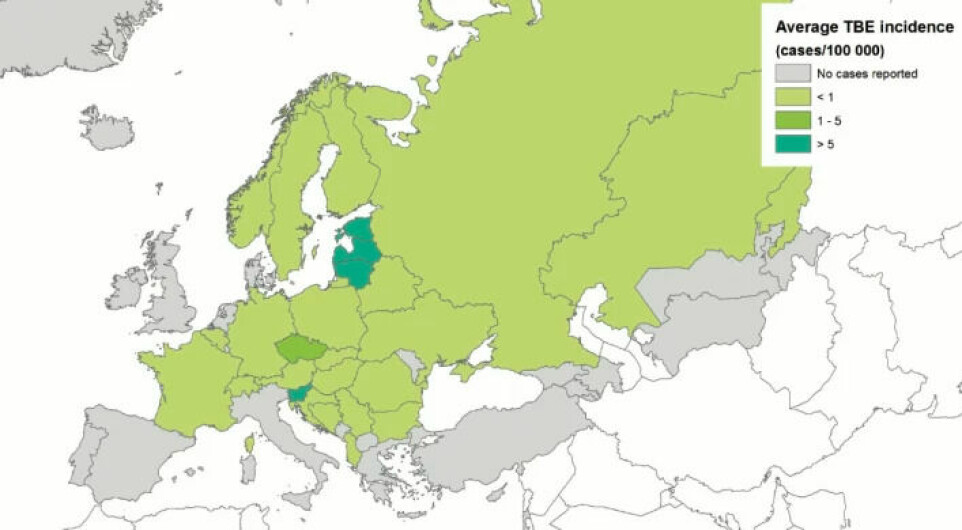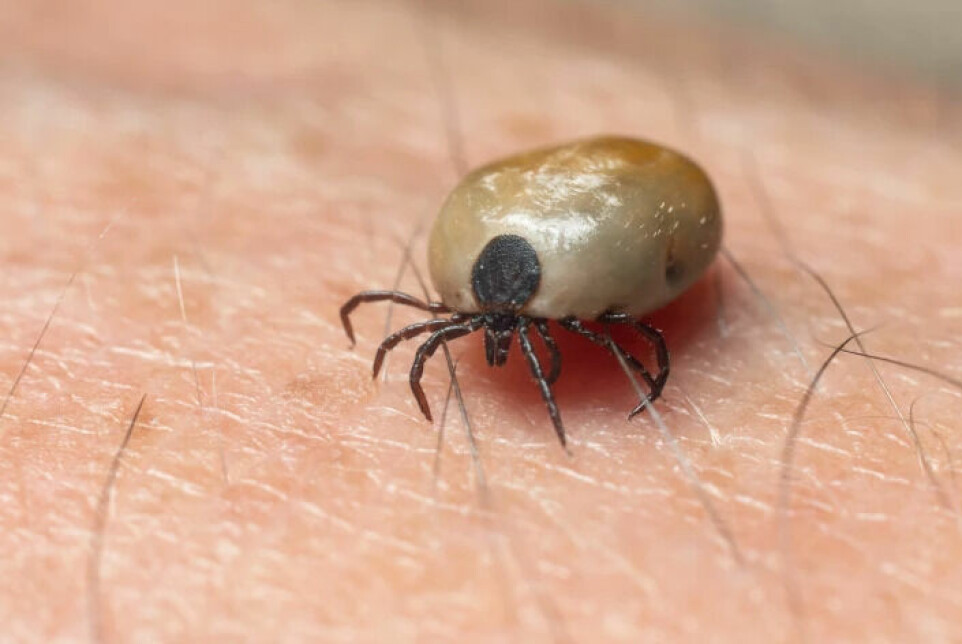
This is how great the risk of infection from ticks is
Researchers find the tick-borne encephalitis virus (TBEV) in as few as 0.3 per cent of the ticks they examine. The Borrelia bacteria can be carried by up to 25 per cent of ticks.
In 2021, 64 cases of TBEV were registered in Norway. The disease can cause inflammation in the brain and in rare cases it can have very serious consequences.
The number of TBEV cases in 2021 was more than doubled compared to three years ago, and the number of Norwegians vaccinated against TBEV has also doubled during this time.
But how likely is it for you to become seriously ill with TBEV?
Little risk
“Even if you are infected with the tick-borne Borrelia bacteria, there is little risk of you becoming seriously ill,” Snorre Stuen, professor and tick researcher at NMBU Faculty of Veterinary Medicine, tells sciencenorway.no.
“It is even less likely that you will become seriously ill from a TBEV infection,” he says.
TBEV and Borrelia are not the only tick-borne infectious agents found in Norway; others include Anaplasma, Babesia and Neoehrlichia.
“What they have in common is that they normally do not cause serious illness in humans, only mild flu-like symptoms 1-4 weeks after the tick has sucked blood,” Stuen says.
Don't trivialise the danger
Stuen doesn't want to downplay the dangers associated with tick-borne diseases.
But he warns against creating increased anxiety about ticks among people who like to spend time outdoors.
The researchers have also discovered some interesting patterns:
“What we see more clearly now is that TBEV is concentrated in small areas that are not connected to each other. Each area can be the size of a football field,” he says.
“The Borrelia bacterium is much more common in ticks everywhere.”
But the amount of Borrelia bacteria in the tick also varies from area to area.
- READ more about ticks in this article from the University of South-Eastern Norway: Warmer climate enables ticks to survive in the high mountains
Why don't people get TBEV everywhere?
Tick researchers in Norway are gathering more and more knowledge.
One of the more interesting findings is that there may have been TBEV in ticks in an area in Northern Norway even though no one has been diagnosed there.
One possible reason for this is that doctors simply haven't thought about diagnosing people this far north with TBEV. Another possible answer is that TBEV only causes mild symptoms in humans.
“This should be investigated further,” Stuen believes.
TBEV has also been detected in several other places up the coast of Norway, without any reports of people falling ill.
“It is mostly only in Southern Norway, Telemark and Vestfold that people are registered as having TBEV. The reason for this is unknown and should also be explored further,” he says.

Few become seriously ill
Most people who get TBEV recover, according to the WHO.
“And only a very small proportion of the ticks in Norway have TBEV,” Stuen emphasises.
“Among those who get the virus, only a small percentage become ill. The rest only get mild symptoms, and often we are talking about symptoms that you barely notice or don't notice at all.”
This is similar to the Borrelia bacteria, which is much more common in ticks.
“It is perhaps only 5-10 per cent of those who are infected with the Borrelia bacteria who become ill. When it comes to disease in humans caused by other tick-borne infectious agents, we have little information,” Stuen says.
Transferred immediately – or after 24 hours
TBEV can be transmitted as soon as the tick begins to suck blood because the infectious agent is already present in the tick's salivary glands.
In the worst-case scenario, TBEV can attack the brain and nervous system.
In order for the Borrelia bacteria to be transmitted, the tick generally has to be attached to your skin for around a day.
This is because these bacteria aren't present in the tick's saliva when it starts sucking blood. They are found further back in the tick.
A common symptom of Lyme disease (which is caused by the Borrelia bacteria) is a red ring around the bite-site, although this does not always occur. Normally, there may be a small red rash where the tick has been. However, if the rash spreads and becomes larger than 5 cm in diameter, you should see a doctor immediately.
Studies have shown that between a quarter and a third of people who are diagnosed with Lyme disease are not aware that they been in contact with a tick.
How is TBEV is transmitted?
In some places in Norway, there is probably a reservoir of TBEV in small rodents such as mice.
Animals such as foxes, bats, hares, deer, sheep, goats, cattle and dogs can also be infected with TBEV.
“But it is mainly infected ticks that transmit the virus to humans, although there have been reports of infection through the consumption of unpasteurised milk and dairy products from infected animals,” Stuen says.
People cannot infect each other with TBEV.

TBEV along the entire coast
Arnulf Soleng is a tick and TBEV specialist at the Norwegian Institute of Public Health (NIPH).
He says it is difficult to predict the development of TBEV in Norway going forward.
“We have had a large increase in TBEV in Vestfold and Telemark in the last two years,” he says.
“But the virus seems to be found almost everywhere in Norway where there are a lot of ticks. We are talking about coastal areas from the Swedish border in the south to Brønnøysund, quite far north.”
The mystery
Soleng and his colleagues at the NIPH have no explanation as to why TBEV-infected ticks in certain places of the country seem to not infect people. They can only speculate as to why this is the case.
It might be that the ticks hold different amounts of the virus. Or are there different types of TBEV in ticks? So-called strains that vary in how easily they cause disease.
“Or is it perhaps that cases of encephalitis (inflammation of the brain) in patients have not been linked to ticks and TBEV?” Soleng speculates.
“Tick-borne encephalitis is only diagnosed if the patient is examined for it.”
The NIPH researcher and the NMBU researcher agree: doctors fail to detect TBEV in their patients.
According to Soleng, a doctoral student at the NIPH is now examining old blood samples from patients with encephalitis, in order to find out more about this.
Lots of uncertainty surrounding TBEV
Soleng, like Stuen, can also confirm that TBEV is something that occurs very locally in Norway.
“TBEV can be present in ticks in a certain place, then disappear, and then reappear,” he says.
“This is definitely something we need to explore further.”
Like Stuen, Soleng is keen to show how little risk there is of becoming seriously ill from TBEV in Norway.
“We receive many inquiries here at the NIPH from people who are afraid of ticks,” Soleng says.
“Quite a few of them have never been bitten by a tick.”
Unfortunate marketing of "tick vaccine"
Soleng thinks it is unfortunate that the vaccine that pharmacies now market against TBEV is also referred to as a "tick vaccine".
“There are many people who misunderstand and think that this is a vaccine against tick bites in general or against Lyme disease,” he says.
“It's important to state that this vaccine is only against TBEV.”
———
Translated by Alette Bjordal Gjellesvik.
Read the Norwegian version of this article on forskning.no
































